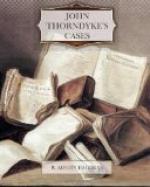“Ah!” exclaimed the inspector.
“But,” continued Thorndyke, “now examine those three letters, and compare them with this note that I wrote in Mr. Barlow’s office. You see that the paper is of the same make, with the same water-mark, but that is of no great significance. What is of crucial importance is this: You see, in each of these letters, two tiny indentations near the bottom corner. Somebody has used compasses or drawing-pins over the packet of notepaper, and the points have made little indentations, which have marked several of the sheets. Now, notepaper is cut to its size after it is folded, and if you stick a pin into the top sheet of a section, the indentations on all the underlying sheets will be at exactly similar distances from the edges and corners of the sheet. But you see that these little dents are all at the same distance from the edges and the corner.” He demonstrated the fact with a pair of compasses. “And now look at this sheet, which I obtained at Mr. Barlow’s office. There are two little indentations—rather faint, but quite visible—near the bottom corner, and when we measure them with the compasses, we find that they are exactly the same distance apart as the others, and the same distance from the edges and the bottom corner. The irresistible conclusion is that these four sheets came from the same packet.”
The inspector started up from his chair, and faced Thorndyke. “Who is this Mr. Barlow?” he asked.
“That,” replied Thorndyke, “is for you to determine; but I can give you a useful hint. There is only one person who benefits by the death of Alfred Hartridge, but he benefits to the extent of twenty thousand pounds. His name is Leonard Wolfe, and I learn from Mr. Marchmont that he is a man of indifferent character—a gambler and a spendthrift. By profession he is an engineer, and he is a capable mechanician. In appearance he is thin, short, fair, and clean-shaven, and he has lost the middle finger of his left hand. Mr. Barlow is also short, thin, and fair, but wears a wig, a board, and spectacles, and always wears a glove on his left hand. I have seen the handwriting of both these gentlemen, and should say that it would be difficult to distinguish one from the other.”
“That’s good enough for me,” said the inspector. “Give me his address, and I’ll have Miss Curtis released at once.”
* * * * *
The same night Leonard Wolfe was arrested at Eltham, in the very act of burying in his garden a large and powerful compressed-air rifle. He was never brought to trial, however, for he had in his pocket a more portable weapon—a large-bore Derringer pistol—with which he managed to terminate an exceedingly ill-spent life.
“And, after all,” was Thorndyke’s comment, when he heard of the event, “he had his uses. He has relieved society of two very bad men, and he has given us a most instructive case. He has shown us how a clever and ingenious criminal may take endless pains to mislead and delude the police, and yet, by inattention to trivial details, may scatter clues broadcast. We can only say to the criminal class generally, in both respects, ‘Go thou and do likewise.’”




